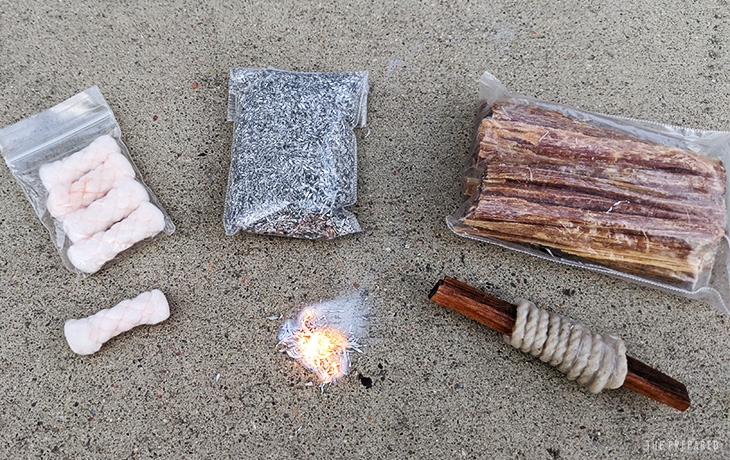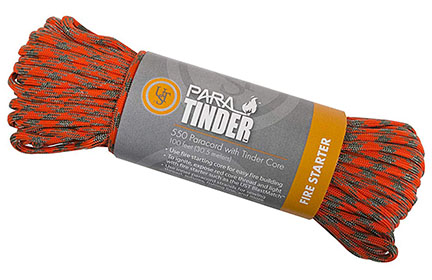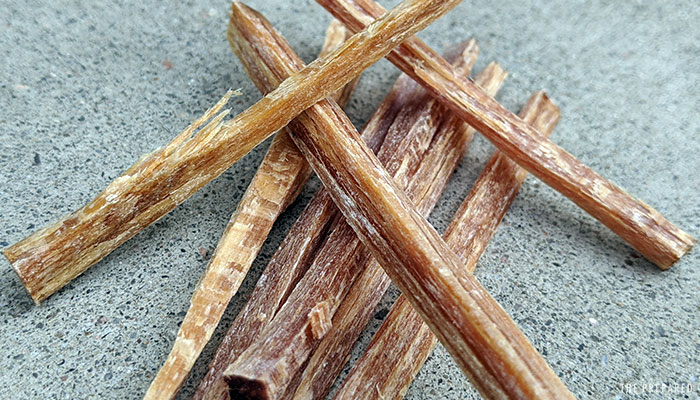This review focuses on tinder that’s appropriate to keep in a portable kit, such as your go-bag, EDC, or vehicle. They work just fine for home supplies too, but there are a few larger products — such as standard “fireplace starter logs” — that you can add when you have more storage space.
The easiest thing to do is buy an off-the-shelf tinder, practice with it, then throw it in your bags and you’re done.
But this is a category where it’s relatively easy to make your own tinder and save some money. If you’re so inclined, those DIY options are covered below, too.
Igniter reviews:
Tinder summary:
- Everyone should have tinder in their primary go-bag — even if you’re comfortable sourcing natural tinder in the field (you might not be able to when you need it!) There’s not much point in carrying an ignition source if you can’t actually turn it into a fire.
- Most types of tinder are either a fiber (eg. cotton) or petroleum-based fuel.
- You can make tinder at home, and they usually work fine, but the safest and easiest way to prep is to buy an off-the-shelf product. DIY instructions are down the page.
- Mix multiple types of tinder so you can cover a wider range of conditions. A common combo is mostly the smaller fiber-based tinder with a few larger fuel cubes to handle harsh conditions.
- Good tinder lasts for at least 1-2 minutes and still works when damp.
- Remember to practice!
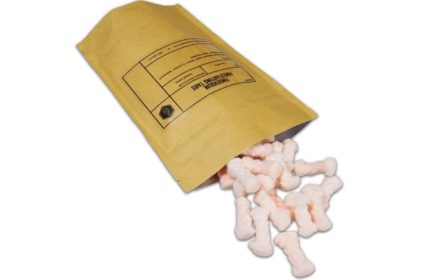
Best for most:
TinderQuik Tab
The best overall choice (and what many of us carry in our go-bags) are TinderQuik Firestarting Tabs. This popular product comes as no surprise to experienced bushcrafters and preppers. TinderQuik tabs are waterproof cotton that’s been condensed into a small package. To use, you simply break a tab apart with your fingers, making it fluffy and ready to catch a spark. Works well with all major ignitors.
At roughly $13 for a 50 pack, that’s $0.25 per fire. They’re small and light enough that you could carry all 50, although we generally recommend carrying at least 10-20 in the bug out bag checklist. 20 tabs only weigh around 0.5 ounces. TinderQuik tabs will last a minimum of 5 years, though if stored at room temperature can last a lot longer.
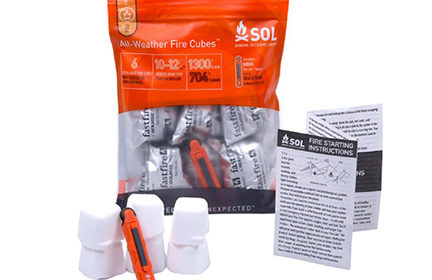
Burns long and hot:
SOL All weather fire cubes
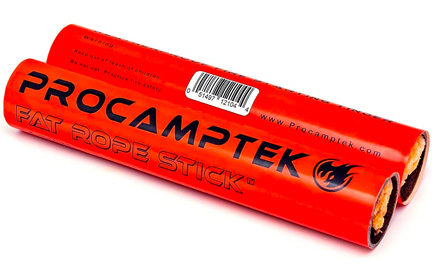
Cut your own:
Fat Rope Stick
Fuel cubes, like the SOL All-Weather Fire Cube, can be a worthy upgrade when you need a very hot starter flame or expect to be dealing with conditions that make fires difficult (eg. you’re in a permanently-damp part of the world.) Roughly $0.60 per fire, or 2-3 times the cost per fire of the basic fibrous/cotton options. Burns for up to 12 minutes at a whopping 1,300 degrees Fahrenheit — perfect for drying out the wet kindling you’re trying to ignite or for directly heating a small stove or canteen to boil water. The cubes are individually wrapped, and weigh .2 ounces which makes it easy to throw one or three in your kit as a backup for your main tabs. We chose the SOL cubes over similar competitor UST Wetfire because the SOL burns twice as long, and unlike Coughlin’s Solid Fuel, tabs are individually wrapped.
If you like the idea of a larger product that you can cut down to size for each need, check out the Fat Rope Stick, a 6” long by 1.5” diameter tube of cotton rope that has been impregnated with a proprietary wax. The wax makes it waterproof and works as an accelerant. They’re pricey at around $17 for two ropes. If you use a common 0.5 inch per fire, that’s roughly $0.70 per fire. Lasts indefinitely when unopened and stored properly, with a claimed life of five years after the package is opened.
Specialty combo:
UST ParaTinder 550 Utility Cord
Although we don’t recommend relying on this as your primary tinder, UST’s ParaTinder 550 Utility Cord is one of the products we tested in the paracord review that has such a feature and stood up to our field abuse. So if you want to build in some extra redundancy by combining products / backups, the more expensive cordage is worth a look.
Be prepared. Don’t be a victim.
Want more great content and giveaways? Sign up for The Prepared’s free newsletter and get the best prepping content straight to your inbox. 1-2 emails a month, 0% spam.
What is tinder and why you need it for fire starting
The easiest way to convince someone of the value of tinder is to ask them to make a fire by holding a match to a log. The match will die before the log ignites 99% of the time.
That’s why people use tinder and kindling as smaller intermediate steps, working their way from a single spark to a roaring flame. Which means the role of tinder is to catch the spark created by your ignitor, ignite quickly, and hold that flame until the kindling catches fire. Think of tinder like the toddler phase of a fire.
Remember the fire triangle:
That’s why tinder (when it’s ready to use) often looks more like a frayed bird’s nest or those hairballs that hide under your bed than a solid chunk of something — each of those little fibers has great exposure to oxygen and can easily “catch” a spark. Most tinder that isn’t frayed or fibrous overcomes that limitation with the help of combustible chemicals (usually petroleum based).
Types of tinder
Humans have used all sorts of stuff for tinder since the discovery of fire. Bark, grass, plants, sap, wood shaving, fungi, dried poop, old bread, and tax returns all work fine — even Doritos and crayons work!
Modern tech has made it easier to carry the most efficient tinder in the smallest, lightest, and/or cheapest package. Most tinder falls into these categories:
- Cordage and fiber
- Fuel blocks
- Metals
- Natural biofuels (eg. fatwood)
Cordage and fibers
Fibrous material like cotton balls, cotton rope, char cloth, paracord, hemp rope, and jute twine can all be used as tinder. They’re often coated with a water-resistant and combustion-accelerant material, such as wax or petroleum distillates, which makes them more effective in harsh conditions.
Products in this category typically burn for 1-2 minutes, are lightweight, easy to carry, easy to make, commercially available, and claim a shelf life of five years (although it’s likely longer).

It’s common to find these products compressed down for packaging and carrying. The TinderQuik tabs, for example, need to be broken up with your fingertips to turn the condensed cotton into that frayed bird’s nest with more volume and oxygen around the fibers.
Some of the top products in this category:
- Baddest Bee Fire Fuse
- Black Beard Fire
- Fat Rope Stick
- Live Fire Original
- Pyro Putty
- TinderQuick
- UST ParaTinder 550 Utility Cord
- Titan SurvivorCord
- Live Fire Gear 550 FireCord
Solid fuel cubes
Individually-wrapped cubes composed of trioxane, hexamine, paraffin wax, and other petroleum distillates.
Some are small and intended to be used as short-term tinder, while others like the Esbit Fuel Tabs can be used as an all-in-one that both catches a spark easily and then burns long enough to be used as a main fuel source — for example, to sit underneath a small camp stove to boil water.
Depending on the size, average tinder cubes will burn for up to five minutes — that extra burn time might make a crucial difference when dealing with wet kindling. They can be extinguished and reused. Solid fuel cubes have a shelf life of 5 years, but during our research, we came across numerous stories of people lighting 20-year-old hexamine bars with no problems.
Top examples:
Metals
Magnesium, which creates a short and intense flame, is best used when it is shaved on to natural tinder such as grass, leaves, down feathers, pine needles, and bark. Although it may look like a big chunky block of metal, magnesium tinder is deceptively lightweight. Magnesium can be purchased in blocks which can be shaved over natural tinder, or bags of magnesium shavings.
Magnesium is a component in ferrocerium (the alloy used in ferro rods) and often found in hybrid products that combine the ferro rod (ignitor) and magnesium (tinder). The Fire-Fast Trekker is an example that we use and like.
Steel wool (superfine #0000) can also be used as tinder, and like magnesium, it doesn’t burn very long and is best used to complement paper or natural tinder, especially in damp environments.
How can steel burn? Because steel wool is composed of thin carbon steel strands with a lot of surface exposure to oxygen, it only takes a little energy in the form of heat to start an uncontrolled combustion reaction. Energy from a match, ferro spark, or electric current is enough to ignite the steel wool.
Many survivalists will keep a handful of superfine #0000 steel wool and a 9-volt battery in their fire supplies. Merely pressing the battery terminals to the steel wool will ignite the bundle. If you choose to keep steel wool, secure the battery so the terminals are not exposed and be mindful of electricity sources.
Other metallic tinders:
- Trolley Shop Magnesium Rod 5-Pack
- Hilitand Magnesium Rod
- Jets emergency fire starter magnesium bags
- Red Devil 0320 steel wool (super fine)
- Homax Steel Wool (super fine)
- Pandora Steel Wool (super fine)
Natural tinder
Any dry organic material technically qualifies as “natural” tinder, but in practice people usually focus on specific types like fatwood and bagasse.
Fatwood, also known as pine knot or rich pine, comes from the stump or heartwood of pine trees. Those trees produce sap, which courses its way through the interior structure of the tree. When the tree ages or dies, evaporation turns that sticky sap into a harder — and very flammable — resin.
You can find fatwood in nature, make it yourself (kind of), or buy it off the shelf. DIY details below, but the punchline is that “forced” fatwood is wood with more of a coating, rather than the natural fatwood that was internally impregnated with the resin.

Bagasse is a dry, fibrous pulp biofuel that’s left over after sorghum and sugarcane have been processed for their main juices. Bagasse is combined with a wax and formed into individual blocks. Bagasse is a common product in the United States and can be found at any big box store like Walmart. It is also common in outdoor or sporting good stores.
Top products:
- Coughlin’s Fire Sticks
- Light My Fire Mayadust
- Light My Fire Tinder-on-a-Rope
- PBL Fatwood
- Plow & Hearth Fatwood Fire Starter
- UCO Sweetfire Fire Starter Tinder
DIY: How to make homemade tinder
The possibilities are endless — especially when you’re improvising in the field in the moment you need a fire — but there are a few common recommendations for DIY tinder that you can make and store ahead of time for portable kits.
Common stuff you’d find around the house or neighborhood
Pros: Free and easy! Cons: Often don’t work as well as proper tinder products. Dry out and compress any of these into a small container and you’re good to go:
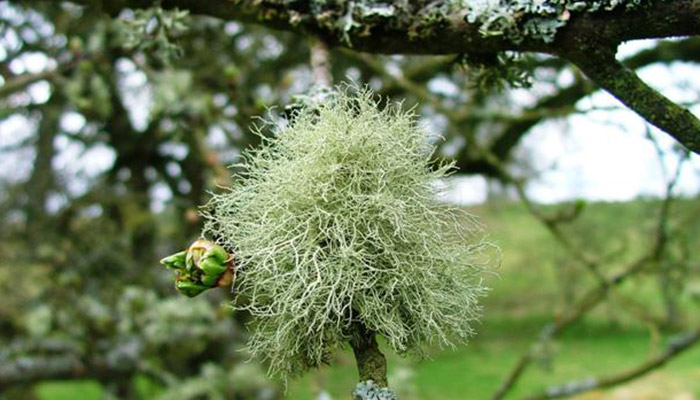
- Old Man’s Beard and similar moss that’s fluffy and flammable (when dry)
- Cedar or Juniper bark. Common in the United States. Shave it or fluff it up for an awesome natural tinder
- Dryer lint — from cotton clothing is awesome. Lint from other clothing sources such as wool, microfiber and polypropylene may smolder, so not a great option, but it works
- Used wet wipes that have dried out
- Biofuels found around your yard, such as dry trimmings
- Newspaper, printer paper, junk mail… any kind of paper that doesn’t have a slick/glossy coating (eg. a magazine)
Cotton balls and paraffin wax or petroleum jelly
Both popular options create a waterproof tinder that works well in the field. Using paraffin is a more involved process, but it’s a little less sloppy, and you avoid the problem of jelly-coatings becoming more fluid in the heat. If you use jelly, try to store the coated balls in a waterproof container (eg. a ziploc bag) so that the viscous jelly doesn’t ruin other stuff.
Jelly:
- All you need is a 100% pure cotton ball and normal petroleum jelly, like what you find in the pharmacy.
- Simply coat a cotton ball in the jelly using your fingers or anything similar. You only need to cover the surface, no need to try and work it deep into the fibers. (You want some internal dry fibers anyway.)
Paraffin:
- Buy Gulf Wax (the most common brand, but anything similar works fine) from your local supermarket. It is commonly found in the canning section.
- Melt the wax in a double boiler. A double boiler setup is where you take a pot and fill it halfway with some water. Turn your burner on medium heat. Take another pot, preferably an old one, place your wax inside the pot, and set it on your first pot. The steam in your first pot will heat up the second pot, and melt the wax.
- Once the wax is melted, turn off your heat source, and stir in your cotton balls.
- When the balls are coated, use tongs to remove and place on parchment paper or similar.
- Let cool.
Fire rope: natural cordage (eg. rope, hemp, jute) and paraffin
Similar concept to the cotton balls:
- Use a natural cord, such as a cotton rope. Be mindful that some cordage already has fire retardant built in for safety, which you obviously want to avoid.
- Cut the length you’d like to store. Some people like to make one long rope they cut down in the field before each fire, while others like to pre-cut.
- Melt paraffin wax in a double boiler.
- Gently swirl in the cord until it’s coated.
- Remove, hang or place on parchment paper, let cool.
Fatwood (sort of)
Real fatwood is hard to fake because it takes years for the natural process of impregnation and evaporation to work. DIY methods like this essentially make waterproof kindling, less so a pure fatwood tinder.
- Source a piece of pine, and using your favorite hatchet, cut the pine into small strips.
- Using your double boiler, melt some paraffin wax or natural tree sap.
- Place the small pieces of pine in the melted wax, and stir them around so they are evenly coated. When coated, remove with some tongs and set aside to cool.
- Store in a ziploc bag or waterproof container.
